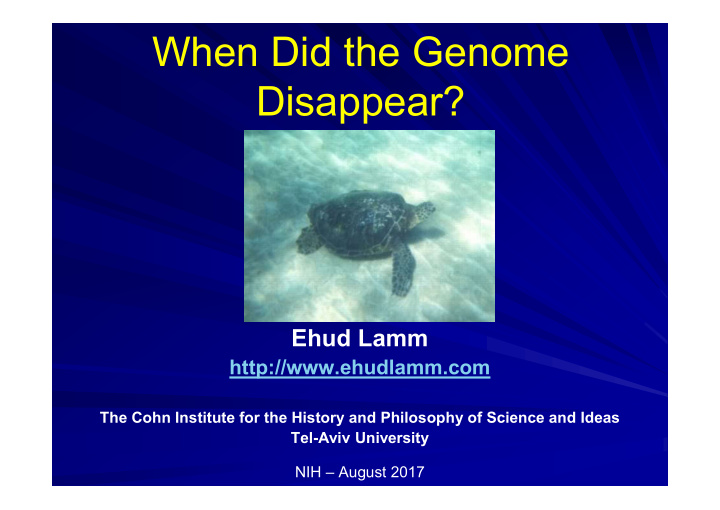



When Did the Genome Disappear? Ehud Lamm http://www.ehudlamm.com The Cohn Institute for the History and Philosophy of Science and Ideas Tel-Aviv University NIH – August 2017
D. radiodurans
Oxytricha trifallax
Johann Friedrich Miescher (1844–1895) Dahm, Hum Genet (2008) 122:565–581
Weissmann’s speculations are struggling with half- chemical terms, which are on the one hand unclear, on the other hand they refer to an older state of chemistry. If, as very possible, one molecule of protein contains 40 asymmetric Carbon atoms, this gives 2^40, this means approximately one billion isomers. And this is only one kind of isomers, and the isomers of nitrogen and the unsaturated valences are not considered. Therefore, to deliver the plurality that is demanded from the theory of heredity, my theory is better suited than any other theory. Through it all transitions from the unnoticeable to the vastest differences become imaginable, however, a thorough scrutinization of this question is in order. (Miescher to Wilhelm His, Basel, 13. Oct. 1893. P122 )
Figures from Flemming (1882) of the division of a living cartilage cell from a Salamander larva. “chromatin” (by 1884 the inh. of chromosomes; 1885 chromatin hypothesized as basis of inheritance)
Figures from Flemming (1882) of dividing epithelial cells from the same source. Fixed and stained.
“systolicher” Stern sternformen fadenknäuel metakynesis
Noteworthy views
Lamm, J Phys (2014)
Which quote is earlier? “GENES within the nucleus are relatively unchanging, permanent hereditary units: they comprise the nuclear genotype. The chromosomes which bear them, on the other hand, change considerably in behaviour and appearance . In this respect the nucleus presents a phenotypic aspect. This nuclear phenotype changes not only during cell division: throughout the life history of any organism it is subject to the control and interaction of the genotype and the environment .”
“… as recently as three decades ago, it was difficult for many traditional geneticists to change their view of genes and chromosomes as static entities, often likened to “beads on a string.” The discovery of transposition was important in providing a new concept of genomes as fluid and dynamic entities . It represented a true paradigm shift whose importance in the history of science has probably not had time to be fully appreciated.”
Defining the concept
Darlington 1932 : “[Genome], a chromosome set, q.v. Winkler, 1916.” (the square brackets indicate the term is not used in the text) Advances in Cytology
Genotype : “the kind or type of the hereditary properties of an organism. Johannsen”. Advances in Cytology
Darlington and Mather 1949 : “Chromosome Set, especially as considered genetically. Winkler 1916.” The Elements of Genetics The term genome was in fact introduced by Winkler (1920). Darlington gives the wrong reference in both of the books I quote here.
Genotype : “1. The kind or type of the hereditary properties of an individual. Johannsen 1909. 2. The hereditary materials considered as a unit.” The Elements of Genetics
Dawkins 1982: “The entire collection of genes possessed by one organism.” (Gene is defined noncommittally as “a unit of heredity”). The Extended Phenotype: The Gene as the Unit of Selection
Genotype : “The genetic constitution of an organism at a particular locus or set of loci. Sometimes used more loosely as the whole genetic counterpart to phenotype.” The Extended Phenotype: The Gene as the Unit of Selection
In modern molecular biology and genetics, the genome is the entirety of an organism's hereditary information. It is encoded either in DNA or, for many types of virus, in RNA. The genome includes both the genes and the non-coding sequences of the DNA/RNA. Wikipedia (29/2/2012)
An organism's complete set of DNA is called its genome. Virtually every single cell in the body contains a complete copy of the approximately 3 billion DNA base pairs, or letters, that make up the human genome. www.Genome.gov http://www.genome.gov/18016863
What happened to the genome-first perspective? Genes became the focus of evolutionary analysis, and when later DNA was discovered to be the bearer of genes, gene coding DNA rather than its surrounding scaffolding became the focus of evolutionary explanation. Lamm, J Physiol 592.11 (2014) pp 2283–2293
As developmental biology and genetics became separate endeavours, the evolutionary significance of the developmental dynamics of the genome fell through the cracks.
Ideas such as Darlington’s, McClintock’s and Dobzhansky’s implied that chromosomal organization offered advantages to species or populations, not individuals.
Three “culprits” Theory Technology The historical narrative
The Genome Reappears? Lieberman-Aiden et al. (2009) Science
“In the future, attention undoubtedly will be centered on the genome, with greater appreciation of its significance as a highly sensitive organ of the cell that monitors genomic activities and corrects common errors, senses unusual and unexpected events, and responds to them, often by restructuring the genome.” McClintock 1984, The Significance of the Responses of the Genome to Challenge.
Thank You Collaborators – Prof. Oren Harman (BIU) – Sophie Juliane Veigl (Universität Wien) – Boaz Tamir (TAU) The Inter-University PhD Program in History and Philosophy of the Life Sciences
Recommend
More recommend